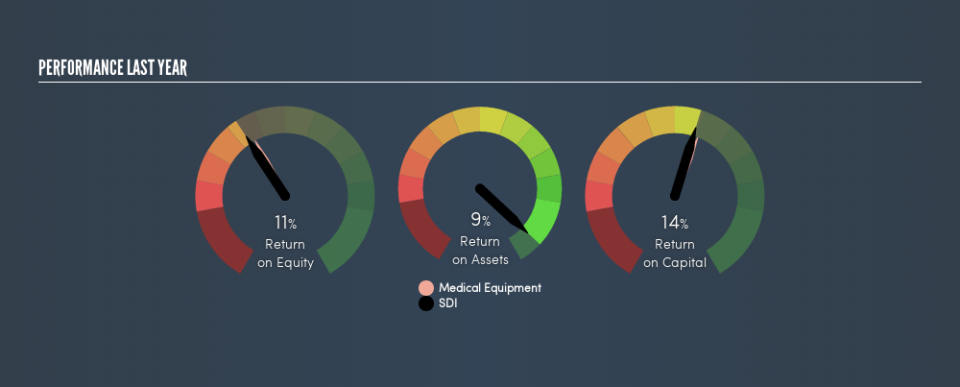Is SDI Limited (ASX:SDI) Better Than Average At Deploying Capital?

Want to participate in a research study? Help shape the future of investing tools and earn a $60 gift card!
Today we are going to look at SDI Limited (ASX:SDI) to see whether it might be an attractive investment prospect. To be precise, we'll consider its Return On Capital Employed (ROCE), as that will inform our view of the quality of the business.
First, we'll go over how we calculate ROCE. Next, we'll compare it to others in its industry. And finally, we'll look at how its current liabilities are impacting its ROCE.
Return On Capital Employed (ROCE): What is it?
ROCE is a metric for evaluating how much pre-tax income (in percentage terms) a company earns on the capital invested in its business. All else being equal, a better business will have a higher ROCE. Overall, it is a valuable metric that has its flaws. Renowned investment researcher Michael Mauboussin has suggested that a high ROCE can indicate that 'one dollar invested in the company generates value of more than one dollar'.
So, How Do We Calculate ROCE?
Analysts use this formula to calculate return on capital employed:
Return on Capital Employed = Earnings Before Interest and Tax (EBIT) ÷ (Total Assets - Current Liabilities)
Or for SDI:
0.14 = AU$10m ÷ (AU$83m - AU$9.0m) (Based on the trailing twelve months to December 2018.)
So, SDI has an ROCE of 14%.
See our latest analysis for SDI
Does SDI Have A Good ROCE?
ROCE can be useful when making comparisons, such as between similar companies. It appears that SDI's ROCE is fairly close to the Medical Equipment industry average of 15%. Independently of how SDI compares to its industry, its ROCE in absolute terms appears decent, and the company may be worthy of closer investigation.
When considering this metric, keep in mind that it is backwards looking, and not necessarily predictive. Companies in cyclical industries can be difficult to understand using ROCE, as returns typically look high during boom times, and low during busts. ROCE is only a point-in-time measure. If SDI is cyclical, it could make sense to check out this free graph of past earnings, revenue and cash flow.
SDI's Current Liabilities And Their Impact On Its ROCE
Current liabilities include invoices, such as supplier payments, short-term debt, or a tax bill, that need to be paid within 12 months. The ROCE equation subtracts current liabilities from capital employed, so a company with a lot of current liabilities appears to have less capital employed, and a higher ROCE than otherwise. To counter this, investors can check if a company has high current liabilities relative to total assets.
SDI has total liabilities of AU$9.0m and total assets of AU$83m. As a result, its current liabilities are equal to approximately 11% of its total assets. Current liabilities are minimal, limiting the impact on ROCE.
The Bottom Line On SDI's ROCE
Overall, SDI has a decent ROCE and could be worthy of further research. You might be able to find a better buy than SDI. If you want a selection of possible winners, check out this free list of interesting companies that trade on a P/E below 20 (but have proven they can grow earnings).
If you are like me, then you will not want to miss this free list of growing companies that insiders are buying.
We aim to bring you long-term focused research analysis driven by fundamental data. Note that our analysis may not factor in the latest price-sensitive company announcements or qualitative material.
If you spot an error that warrants correction, please contact the editor at editorial-team@simplywallst.com. This article by Simply Wall St is general in nature. It does not constitute a recommendation to buy or sell any stock, and does not take account of your objectives, or your financial situation. Simply Wall St has no position in the stocks mentioned. Thank you for reading.

